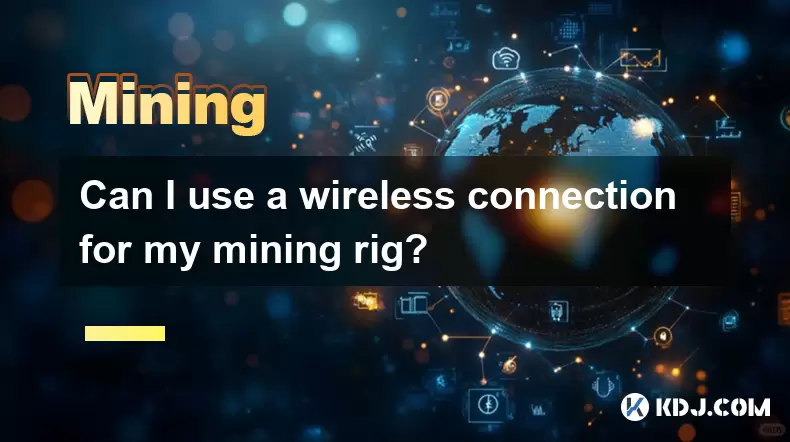-
 bitcoin
bitcoin $120167.907534 USD
1.27% -
 ethereum
ethereum $4468.611945 USD
2.53% -
 xrp
xrp $3.013607 USD
1.80% -
 tether
tether $1.000549 USD
-0.01% -
 bnb
bnb $1092.592149 USD
6.28% -
 solana
solana $231.391244 USD
4.59% -
 usd-coin
usd-coin $0.999699 USD
-0.04% -
 dogecoin
dogecoin $0.259020 USD
4.30% -
 tron
tron $0.342747 USD
0.34% -
 cardano
cardano $0.860977 USD
1.07% -
 hyperliquid
hyperliquid $50.155412 USD
5.34% -
 chainlink
chainlink $22.637678 USD
0.46% -
 ethena-usde
ethena-usde $1.000528 USD
-0.07% -
 avalanche
avalanche $30.613779 USD
-0.07% -
 stellar
stellar $0.403905 USD
0.94%
Can I use a wireless connection for my mining rig?
A stable internet connection is crucial for mining rigs, and while Wi-Fi can work, Ethernet is preferred for lower latency and fewer rejected shares.
Aug 12, 2025 at 03:49 am

Understanding the Role of Internet Connectivity in Mining Rigs
When operating a cryptocurrency mining rig, a stable and reliable internet connection is essential for communicating with the blockchain network and mining pools. The primary function of the internet connection in mining is to transmit hash results, receive new work units, and synchronize with the pool server. While many assume a wired Ethernet connection is mandatory, the use of a wireless (Wi-Fi) connection is technically possible. The key consideration is not whether wireless works, but how it impacts performance, stability, and uptime. Mining rigs do not require high bandwidth, but they do demand low latency and consistent connectivity. Any interruption or packet loss can result in rejected shares, reducing mining efficiency.
Performance Comparison: Wi-Fi vs. Ethernet
Although Wi-Fi can support mining operations, Ethernet remains the preferred method due to its reliability. A wired connection provides a dedicated, interference-free pathway between the mining rig and the router or switch. In contrast, Wi-Fi signals are susceptible to interference from walls, appliances, and other wireless networks. This can lead to increased latency and intermittent disconnections. Even minor delays in submitting shares to a mining pool can result in those shares being rejected, directly affecting profitability. For example, if your rig submits a share 2 seconds late due to a Wi-Fi dropout, the pool may already have moved on to the next block, rendering your work invalid. Therefore, while Wi-Fi can function, it introduces variables that may compromise mining efficiency.
Setting Up a Mining Rig with Wi-Fi: Step-by-Step
If you choose to use a wireless connection, ensure your setup maximizes stability. Begin by selecting a high-quality Wi-Fi adapter compatible with your rig’s operating system (e.g., HiveOS, Windows, or Linux). Plug the adapter into a USB port on the motherboard. Next, boot the system and access the network settings. Follow these steps:
- Navigate to the network configuration interface of your mining OS.
- Scan for available Wi-Fi networks and select your router’s SSID.
- Enter the Wi-Fi password using the correct encryption type (WPA2 or WPA3).
- Assign a static IP address to prevent DHCP-related disconnections.
- Test the connection by pinging the pool server (e.g.,
ping stratum+tcp://pool.example.com).
After successful connection, monitor the packet loss and latency using tools like ping or mtr. A stable connection should show 0% packet loss and latency under 50ms. If performance is inconsistent, consider relocating the rig closer to the router or using a Wi-Fi extender with a strong signal.
Optimizing Wi-Fi for Mining: Best Practices
To minimize the risks of using Wi-Fi, implement several optimization strategies. Use the 5 GHz band instead of 2.4 GHz, as it offers faster speeds and less interference, although with shorter range. Ensure your router firmware is up to date and Quality of Service (QoS) settings prioritize traffic from the mining rig. Configure the router to assign a reserved IP address based on the Wi-Fi adapter’s MAC address. This prevents IP changes during reboots. Additionally, disable power-saving modes on the Wi-Fi adapter, as these can cause the interface to sleep and drop the connection. In Linux-based mining systems, edit the network manager configuration to prevent auto-suspend:
- Open the terminal and edit the network configuration file:
sudo nano /etc/NetworkManager/conf.d/default-wifi-powersave-on.conf - Add the line:
[connection] wifi.powersave = 2 - Save and restart NetworkManager:
sudo systemctl restart NetworkManager
These adjustments help maintain a persistent and responsive connection.
Monitoring and Troubleshooting Wireless Mining Connections
Even with optimizations, Wi-Fi connections require ongoing monitoring. Use built-in tools in your mining software (e.g., HiveOS dashboard or Claymore’s miner interface) to track rejected shares and uptime. A sudden spike in rejected shares may indicate connectivity issues. Set up automated scripts to reconnect the Wi-Fi interface if the connection drops. For example, create a bash script that pings Google’s DNS every minute:
- Write a script:
#!/bin/bashif ! ping -c 1 8.8.8.8 &> /dev/null; thennmcli con up id 'Your-WiFi-SSID'fi - Make it executable:
chmod +x /path/to/check_wifi.sh - Schedule it with cron:
crontab -e* /path/to/check_wifi.sh
This ensures automatic recovery from brief outages. Additionally, check the Wi-Fi signal strength regularly. On Linux, use:iwconfig wlan0 | grep 'Signal level'A signal above -60 dBm is ideal; below -70 dBm indicates poor reception.
When Wi-Fi Might Be Acceptable
There are scenarios where Wi-Fi is a practical choice. If the mining rig is located in a temporary setup, such as a garage or outdoor shed where running Ethernet cables is impractical, Wi-Fi offers necessary flexibility. Similarly, in co-location setups with managed networking, the provider may offer a strong, dedicated Wi-Fi signal. Portable mining units or demonstration rigs used at events often rely on wireless for mobility. In such cases, using a dual-band Wi-Fi 6 adapter with MIMO technology can deliver near-Ethernet performance. However, even in these situations, a wired backhaul or Ethernet over power (MoCA) should be considered if long-term stability is required.
Frequently Asked Questions
Can a mining rig lose profits due to Wi-Fi latency?Yes. Even small delays in submitting shares can result in rejected shares, especially on high-difficulty pools. If your Wi-Fi connection has frequent latency spikes above 100ms or packet loss, your effective hash rate may drop significantly, reducing earnings.
Is it safe to use public Wi-Fi for mining?No. Public networks lack encryption and are monitored, making them high-risk for exposing your mining pool credentials. Always use a private, password-protected network with WPA2/WPA3 encryption.
Will a USB Wi-Fi dongle work with HiveOS?Most modern USB Wi-Fi adapters are supported, but check the HiveOS compatibility list. Adapters using Atheros, Intel, or Broadcom chips with open-source Linux drivers (e.g., ath9k, iwlwifi) work best. Avoid adapters requiring proprietary drivers.
Can I use a mobile hotspot for mining?Technically yes, but data caps and throttling make it impractical. Mining generates continuous background traffic. Most mobile plans limit data or reduce speeds after a threshold, leading to disconnections and reduced efficiency.
Disclaimer:info@kdj.com
The information provided is not trading advice. kdj.com does not assume any responsibility for any investments made based on the information provided in this article. Cryptocurrencies are highly volatile and it is highly recommended that you invest with caution after thorough research!
If you believe that the content used on this website infringes your copyright, please contact us immediately (info@kdj.com) and we will delete it promptly.
- BlockDAG, DOGE, HYPE Sponsorship: Crypto Trends Shaping 2025
- 2025-10-01 00:25:13
- Deutsche Börse and Circle: A StableCoin Adoption Powerhouse in Europe
- 2025-10-01 00:25:13
- BlockDAG's Presale Buzz: Is It the Crypto to Watch in October 2025?
- 2025-10-01 00:30:13
- Bitcoin, Crypto, and IQ: When Genius Meets Digital Gold?
- 2025-10-01 00:30:13
- Stablecoins, American Innovation, and Wallet Tokens: The Next Frontier
- 2025-10-01 00:35:12
- NBU, Coins, and Crypto in Ukraine: A New Yorker's Take
- 2025-10-01 00:45:14
Related knowledge

The difference between staking and mining
Sep 24,2025 at 05:18am
Understanding Staking in the Cryptocurrency Ecosystem1. Staking involves holding funds in a cryptocurrency wallet to support the operations of a block...

How to participate in testnet mining?
Sep 22,2025 at 09:18am
Understanding Testnet Mining in the Crypto Ecosystem1. Testnet mining is a method used by blockchain developers to simulate real-world conditions on a...

How to dispose of abandoned mining machines?
Sep 19,2025 at 08:19pm
Assessing the Condition of Abandoned Mining Rigs1. Begin by inspecting each mining machine for visible damage, corrosion, or missing components. Machi...

How to identify high-quality mining pools?
Sep 21,2025 at 03:19pm
Reputation and Track Record1. A mining pool’s reputation is built over time through consistent performance and transparency. Pools that have operated ...

Advantages of decentralized mining pools
Sep 20,2025 at 04:36pm
Enhanced Security and Resistance to Censorship1. Decentralized mining pools operate on blockchain-based smart contracts, eliminating the need for a ce...

What is mining machine overclocking?
Sep 21,2025 at 07:19pm
Understanding Mining Machine Overclocking1. Mining machine overclocking refers to the process of increasing the operating frequency of a cryptocurrenc...

The difference between staking and mining
Sep 24,2025 at 05:18am
Understanding Staking in the Cryptocurrency Ecosystem1. Staking involves holding funds in a cryptocurrency wallet to support the operations of a block...

How to participate in testnet mining?
Sep 22,2025 at 09:18am
Understanding Testnet Mining in the Crypto Ecosystem1. Testnet mining is a method used by blockchain developers to simulate real-world conditions on a...

How to dispose of abandoned mining machines?
Sep 19,2025 at 08:19pm
Assessing the Condition of Abandoned Mining Rigs1. Begin by inspecting each mining machine for visible damage, corrosion, or missing components. Machi...

How to identify high-quality mining pools?
Sep 21,2025 at 03:19pm
Reputation and Track Record1. A mining pool’s reputation is built over time through consistent performance and transparency. Pools that have operated ...

Advantages of decentralized mining pools
Sep 20,2025 at 04:36pm
Enhanced Security and Resistance to Censorship1. Decentralized mining pools operate on blockchain-based smart contracts, eliminating the need for a ce...

What is mining machine overclocking?
Sep 21,2025 at 07:19pm
Understanding Mining Machine Overclocking1. Mining machine overclocking refers to the process of increasing the operating frequency of a cryptocurrenc...
See all articles










































































